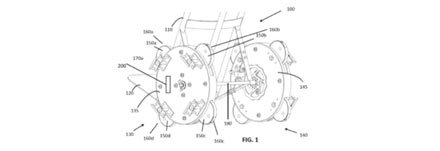Patents are a virtue: Apple’s elevator music, stair-climbing wheels and a shower dryer

Apple’s improved speakers
Apple was recently granted a patent, US 8,767,994, for an improved speaker. What is interesting is that the improvement is targeted at those critical seconds of time when the listener uses the speaker while riding up or down an elevator. Typical gas-filled speakers are filled with gas that is less dense than air in order to enlarge the volume of the speaker enclosure behind the speaker’s vibrating diaphragm. This results in improved sound quality over air-filled speakers.

However, when the speaker is subjected to an abrupt change in pressure, such as inside a moving elevator, the change in pressure results in a net force acting on the diaphragm. This can cause the diaphragm ‘to stick and therefore stop producing sound until the pressure inside the speaker has equalised with the barometer pressure’.
While air-filled speakers equalise quickly as vent holes are provided, gas-filled speakers need to be fully enclosed. The invention is a gas-filled speaker enclosure (see image number 120) with a flexible, gas-impermeable membrane partition (112). On the other side of the partition is an air-filled chamber (130) with a vent (132) to allow pressure equalisation.
In response to external pressure changes, the flexible membrane (112) flexes to allow corresponding expansion or contraction of the gas inside the gas-filled chamber, therefore preventing the diaphragm (140) from sticking. The other side of the membrane is at barometric pressure, since air can leak out of the vent (132). The patent also describes how a similar structure may be added to earphones.
Stair-climbing wheels
The wheel was a great invention. So were stairs. But unfortunately, the two were not meant to go together. Patent US 8,764,028, recently issued to Mann et al., offers a stair-climbing solution. The invention consists of deployable secondary wheels (image numbers 150a, 150b, 150c, 150d) which protrude from the main wheel.
The secondary wheels can be retracted when on a level surface, so that they do not interfere with the operation of the main wheel. To climb stairs, the secondary wheels are spaced such that one secondary wheel remains on a lower step while an adjacent secondary wheel is positioned on an upper step.

The top wheel acts as a lever about which the main wheel can be rotated, to raise the wheel, and simultaneously position a third secondary wheel onto the next step to repeat the process. The invention obviously relies on the fact that stairs are generally of an average height. However, for some added flexibility, more than four secondary wheels could be provided, each being individually deployable. Shorter steps would require more secondary wheels to be deployed. The applicants have described that these wheels could be used on anything from hand trucks to wheel chairs, Segways® and bicycles.
Who likes a wet shower?
Who likes a wet shower cubicle to be precise? As detailed in patent US 8,713,814 to Martin, J., leaving a cubicle damp promotes mould and mildew, and leaves residue from iron, calcium, soap, etc, as deposits on the walls when the water evaporates. The solution: blast the cubicle with hot drying air. More specifically, the drying air must come from above, so that it is directed downwardly and towards the walls of the cubicle. This is so that the water on the walls either evaporates or flows downwards towards the drain.

?The dryer system is controlled via a humidity sensor which detects a drop in humidity. Alternatively, two sensors could be provided, one inside the cubicle and one outside, and the drying process maintained until the internal sensor measures the same humidity as the external sensor. Other claims require that the air is blown through louvers or nozzles in the ceiling, which direct the air towards the cubicle walls. The applicant also owns another patent to a similar system including a second blower for exhausting the humid air generated from evaporation of the water from the walls.




